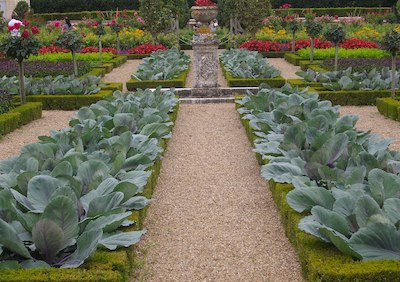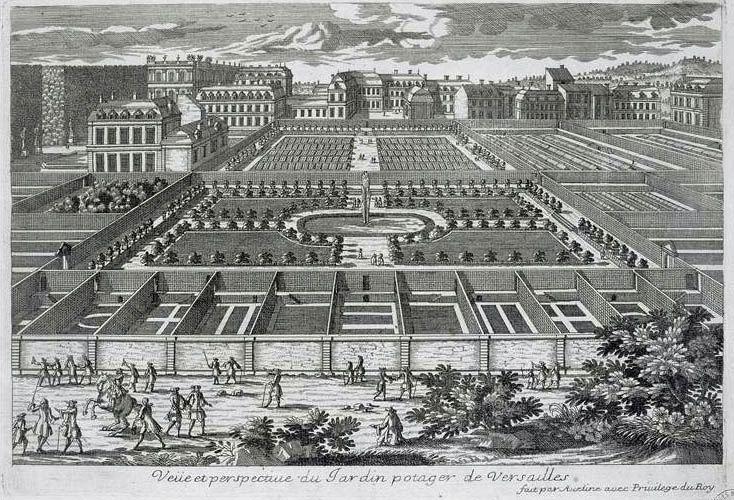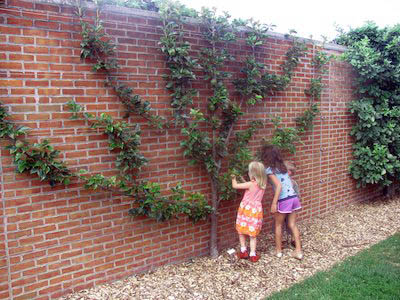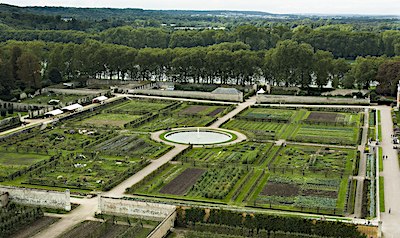Grow Like A King
By Kathleen Ellen Driscoll, Fairfax Master Gardener Intern
“A good gardener must have passion for new discoveries”
~Jean-Baptiste de La Quintinie, 1690

French potager
Winter vegetables and fruit are welcome and invigorating dinner guests in crisp October, but by dark and dreary February, parsnips, turnips and kale can feel like they’ve outstayed their welcome; even the most delicious apple has turned to sauce. And we begin to long for the spark of spring to brighten our souls and our plates from our annual five-month growing hiatus. Louis XIV agreed and the Jardin Potager du Roi, the Royal French Kitchen Garden, was created under the tutelage of Jean-Baptiste de La Quintinie, agronomist and Directeur Général des Potagers Royaux. Centuries later the idea of an edible landscape that combines form and function, beauty and utility still intrigues us.
Using an artful design, revolutionary agricultural techniques and nearly year-round harvests, the Versailles potager is, beyond question, the world’s most visually beautiful and intellectually stunning vegetable patch. By interspersing herbs, vegetables and cutting flowers, this garden seems to be the best of all possible worlds by its inventive use of limited space for maximum food production.
Exactly what is a potager?
Historically, the French kitchen garden design, and plants contained within, have been marvelously adaptable. Blend the medieval monastery, with its vegetable patch, physic garden of medicinal plants and kitchen garden of culinary herbs, with the Renaissance garden connection between house and garden, geometric parterres and bordered pathways, sprinkled in citrus trees and clipped topiary. Voilà the potager emerged.

Versailles potager plan
From the mid-17th century, the origin of the word potager is Medieval French. It literally means a “garden providing vegetables for the “pot.” From the word potage, meaning a thick vegetable soup, the English word porridge developed. Ever an issue of nutrition, fresh herbs, fruits and vegetables have long played a significant role in everyone’s garden and leave it to the French to charm you into eating your petits pois, and haricots verts. In more recent times the potager has been incorporated into the locavore movement of growing and eating local food. Nurturing a harvest of fruit and vegetables for the table, while maintaining a pleasing garden aesthetic is a challenge. Yet with some planning and regal inspiration it is within our reach.
What was grown in the royal garden?
“Among the King’s other favorite vegetables were cauliflower, artichoke hearts and, above all, asparagus.
No royal supper was complete without salad. He consumed ‘a prodigious quantity’ year round. And the term ‘salad’ encompassed much more than a few varieties of lettuce: cresses, chervil, parsley, rocket, basil, purslane, mint, celery, wood sorrel, tarragon, salad burnet, lemon balm and violets.”

Espalier tree
As a decorative technique, the espaliered apple, pear, peach and plum trees enhanced the architecture of the winter garden with strong sculpted lines, varying bark texture and dramatic shape. This space-saving practice allowed for a greater variety of trees in a small area that cast little shadow on surrounding plants. The controlled tree growth was more efficient for fruit production and offered easier access for harvesting. Trellised to stone walls, the espaliered fruit trees were geometrically-shaped, visually flat and grown in two-dimensional horizontal lines; their form often suggested a candelabra or goblet. A brick wall would do the trick now. Furthermore, not only did espaliered trees produce earlier but they also outproduced fruit trees grown in a more traditional orchard setting.
“The garden was bewilderingly well stocked — alongside the King’s favorite fruits and vegetables, grew bay trees, beans, salsify, gooseberries, strawberries, plums, spinach, eggplants, cucumbers, nectarines, apricots, muscat grapes, cherries, currants of several colors and cardoons, as well as the more common carrots, parsnips, cabbages, onions, shallots, leeks and turnips.”
There was a melon patch and garden squares earmarked for strawberries or cherries.
How was it done? Can I do it in my garden?
Through a variety of techniques and innovations, M. de La Quintinie applied his horticultural knowledge to great scientific and artistic advantage. His personal experience guided the many methods employed to lengthen the growing season. His arrangement of complementary plant groups and the addition of warmth-generating decomposing manure created different microclimates that elevated the temperature the necessary few degrees warmer to produce varieties of fruits and vegetables consistently.
Early geo-thermal heating techniques were applied that prolonged the growing season.
Unheated cold frames insulated seedlings. Glass partitions encouraged sunlight and heat but discouraged insects. Heat-capturing stonewalls supported attached fruit trees. Raised plant beds of herbs, scented flowers and ornamentals were insulated by straw and protected from the cold under cloches, bell-shaped glass covers.
With the use of cold frames or sheets of plastic coverings in raised beds with good drainage and plenty of organic material, sufficient heat can be produced to nurture plants in your garden, too.

Versailles potager
About the design
The potager is a graphic example of the 17th century gardening principle of imposing man-made order on nature. Organization, balance and control were key landscaping considerations. Based on scientific experiments and practical observations, herbs, edible flowers, espaliered fruit trees and berry bushes thrived in de La Quintinie’s innovative geometric design and bold layout.
The potager remains a combination of lowly kitchen garden and formal parterre. Inside an enclosure — typically myrtle or boxwood — a grid divided into four sections surrounds a central object (circular basin; a fountain; strawberry pot, for example) from which pea gravel pathways radiate. The walkways are essential, as this vegetable garden is meant to be enjoyed for its sensual delights as well as its practical bounty. Furthermore, the espaliered trees are striking focal points in the garden.
L’Orangerie, a type of citrus greenhouse inspired La Figuerie for fig trees in large wooden boxes/pots. Indoor plants were moved in and out of the buildings according to the season.
Defining potager elements
Even if you do not have a spare 23 acres and are not the king of France, there are still some ways that you can employ elements of the potager in your own garden. And remember: the Roi du Soleil faced the same growing challenges — drainage, fertile soil, cold weather — that Northern Virginia gardeners do today.
Consider shaping your garden using any or all of the defining elements of the potager.
Order over Nature – Traditionally, a potager is symmetrical or geometric. Parterres and raised beds are common features. Wise space planning is essential. This is a year-round garden; plan for seasonal beauty and bounty in plant selection.
Structure – Visual interest is based on the traditional gardening principles of order, proportion, repetition and unity. Color and harmony/contrast are also to be considered.
Enclosed Plot – The enclosure can be organic (boxwood; lavender; myrtle) or inorganic (stone wall; row of containers). This protects the plantings from harsh weather and can capture warmth.
Pathways – Pathways are design features, permit ease of access and create a corridor to totally experience the garden. Pea gravel is the traditional material but stepping stones, mulch or bricks work well.
Focal Point – Visual interest and food output are equally important in this garden. Various focal points to consider would be urns, strawberry pots, bird baths, sundial/armillarias, statuary and obelisks.
On your next field trip to France, you can stop by the royal potager at 6 rue Hardy, Versailles for first-hand inspiration. Within walking distance of the palace but distinct from the pleasure gardens, it is a 10-minute walk from the chateau and well worth the visit.
Resources
potager, Oxford Dictionaries, Oxford University Press
Where Versailles Grew Its Veggies, Catherine Reynolds, New York Times, September 11, 1994
King Louis XIV’s fruit and vegetable garden, Travel Guide: Paris to Versailles
Si Versailles m’était planté : le Potager du Roi, A L’Encre Violette